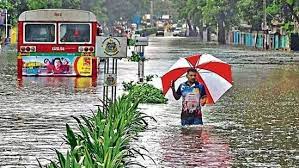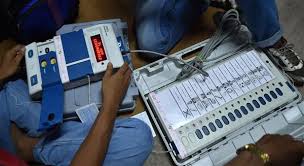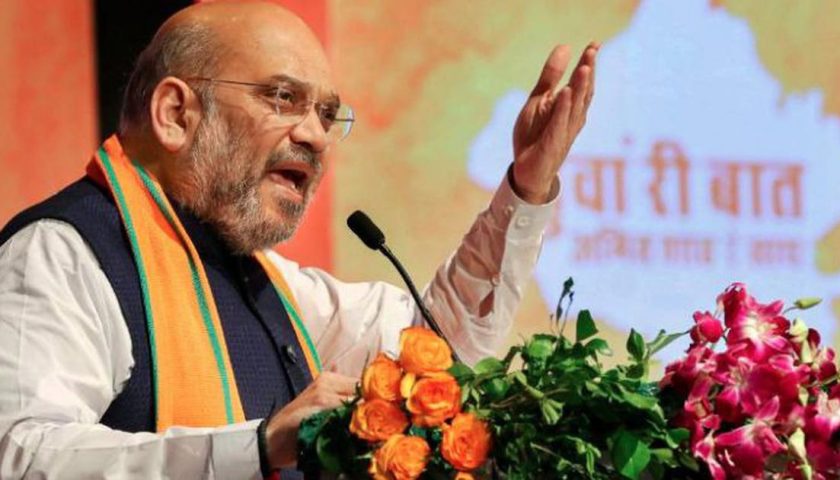Several parts of India experienced extreme weather conditions on Monday — there was flooding in the northeastern states including Assam and Sikkim, heavy rain in arid Rajasthan triggered by cyclone Biparjoy, waterlogging in parts of Tamil Nadu, and the death toll from the heatwave in eastern Uttar Pradesh, Bihar and Odisha climbed to 114— as weather vagaries laid bare the impact of the climate crisis.
While the monsoon has arrived only in parts of southern and northeastern India — it advanced into some parts of Karnataka, Andhra Pradesh, parts of Gangetic West Bengal and Jharkhand, parts of Bihar and Sikkim on Monday, according to IMD (India Meteorological Department) — Rajasthan and Gujarat have recorded rainfall in excess of 200%. Eastern Uttar Pradesh, Bihar and Odisha are reeling under scorching heat with a nearly 90% rainfall deficit. The monsoon usually reaches these parts by June 15, according to a map released by IMD on Monday.
Experts attributed the unusual weather tothe overall warming of the planet and the climate crisis. The globally available data makes it clear the climate crisis is leading to more extreme weather events, with the frequency of cyclones also on the rise.
“The impact of climate change is most visible across three hotspots — the Himalayas, coastal regions and semi-arid to arid regions and India has all three. We are seeing more rain, incessant spells in the mountains, an increase in the sea level and an increase in the number and severity of cyclones in the coastal region and more heatwaves in the arid region. A delayed monsoon and cyclone Biparjoy are both linked to this long-term impact,” said Anjal Prakash, associate professor at Bharti Institute of Public Policy, Indian School of Business (ISB), and lead author of the two of the Intergovernmental Panel on Climate Change (IPCC) reports.
The Indian monsoon has changed in recent years and not for the better, he said.
“Earlier forecasts showed the monsoon would still be normal, but now it is likely to be deficient and these are things that are constantly changing,” he added.
In UP’s Ballia, 14 more people admitted at the district hospital died of different ailments, taking the death toll at the hospital to 68 in last four days. While officials have not attributed these days to extreme heat, people were brought to the hospital with high fever, and confusion — symptoms of hyperthermia.
While high temperatures raise the risk of hyperthermia or heatstroke, even lower temperatures, when coupled with high humidity, can be dangerous as the body struggles to cool down through perspiration.Temperatures, relative humidity and wind speed factored in collectively represent the heat index or the “feels like temperature”, which is a more accurate tool to assess risk.
On Monday, Patna in Bihar — which accounted for a bulk of the deaths — recorded a temperature of 43.2°C and a relative humidity of 42%. This took the heat index of the city to 59°C.
Prolonged exposure to a heat index between 40-54°is associated with heatstroke.
The northeast, meanwhile, is witnessing flash floods, with at least 33,000 people in Assam affected, and torrential rain triggering multiple landslides in Sikkim.
On Monday, the Assam State Disaster Management Authority said that the state’s 142 villages are under water and 1,510.98 hectares of crop areas have been damaged.In Sikkim, the Indian Army rescued 300 tourists who were stranded after landslides and roadblocks, an official statement said.
On Monday, IMD scientist Naresh Kumar said, “There is monsoon rainfall over northeast India; the remnant of cyclone Biparjoy is bringing rainfall to Rajasthan, Punjab, Madhya Pradesh. Moist winds from Arabian Sea are also causing rainfall in higher reaches like Uttarakhand. Monsoon has not reached east India yet. The heat stress over Bihar, Uttar Pradesh etc will gradually abate.”
IMD director general M Mohapatra said, “Temperatures are expected to drop over Uttar Pradesh, Bihar, parts of West Bengal in the next two days. There will be relief from heat.”
In the wake of the cyclone, north Gujarat has been affected by incessant rains, leading to a flood-like situation in parts of Banaskantha, Sabarkantha and Patan districts.“The present rainfall in Gujarat is only due to the cyclone. There is a good amount of rainfall in Saurashtra and Kutch while in other parts the rainfall is nominal,” said Manorama Mohanty, IMD director, Ahmedabad, said.
On Monday, southeast and northeast Rajasthan, and western Madhya Pradesh also received light to moderate rainfall, with isolated instances of heavy to very heavy rainfall.
The sluggish monsoon and extreme weather have also slowed the planting of key kharif or summer-sown crops, which account for half of India’s annual food output and has a bearing on consumer prices, official data show.
The rain bearing system, the lifeblood of Asia’s third-largest economy, was 47% below normal between June1-13, the period for which sowing data are available. While monsoon has covered most parts of southern India till Monday, the states have recorded a deficit in rain.






